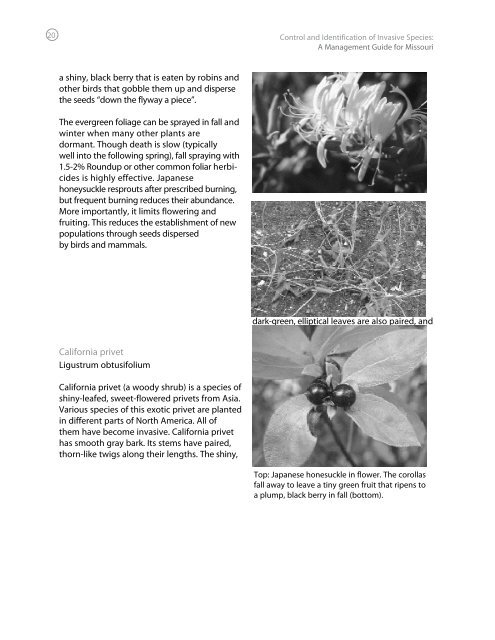Control and Identification of Invasive Species - Grow Native
Control and Identification of Invasive Species - Grow Native
Control and Identification of Invasive Species - Grow Native
You also want an ePaper? Increase the reach of your titles
YUMPU automatically turns print PDFs into web optimized ePapers that Google loves.
20<strong>Control</strong> <strong>and</strong> <strong>Identification</strong> <strong>of</strong> <strong>Invasive</strong> <strong>Species</strong>:A Management Guide for Missouria shiny, black berry that is eaten by robins <strong>and</strong>other birds that gobble them up <strong>and</strong> dispersethe seeds “down the flyway a piece”.The evergreen foliage can be sprayed in fall <strong>and</strong>winter when many other plants aredormant. Though death is slow (typicallywell into the following spring), fall spraying with1.5-2% Roundup or other common foliar herbicidesis highly effective. Japanesehoneysuckle resprouts after prescribed burning,but frequent burning reduces their abundance.More importantly, it limits flowering <strong>and</strong>fruiting. This reduces the establishment <strong>of</strong> newpopulations through seeds dispersedby birds <strong>and</strong> mammals.dark-green, elliptical leaves are also paired, <strong>and</strong>California privetLigustrum obtusifoliumCalifornia privet (a woody shrub) is a species <strong>of</strong>shiny-leafed, sweet-flowered privets from Asia.Various species <strong>of</strong> this exotic privet are plantedin different parts <strong>of</strong> North America. All <strong>of</strong>them have become invasive. California privethas smooth gray bark. Its stems have paired,thorn-like twigs along their lengths. The shiny,Top: Japanese honesuckle in flower. The corollasfall away to leave a tiny green fruit that ripens toa plump, black berry in fall (bottom).


